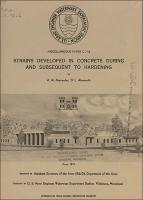Please use this identifier to cite or link to this item:
https://hdl.handle.net/11681/11460| Title: | Strains developed in concrete during and subsequent to hardening |
| Authors: | United States. Assistant Secretary of the Army (R & D) Alexander, A. Michel Ainsworth, Donnie L. |
| Keywords: | Concrete Strain |
| Publisher: | Concrete Laboratory (U.S.) Engineer Research and Development Center (U.S.) |
| Series/Report no.: | Miscellaneous paper (U.S. Army Engineer Waterways Experiment Station) ; C-71-6. |
| Description: | Miscellaneous paper Abstract: The recording of unexpectedly large tensile strain readings in early-age concrete by Port Allen Lock and Lackland Air Force Base on the Drilled Pier Test Section (DPTS} prompted this investigation on Tests- were conducted on a smaller scale- to ascertain whether the readings were due to instrumental errors, stress-induced strains or growth of the concrete due to hydration. Three distinct strain meters were installed in a simulated pier having the same mix design as used in the DPI'S. They were (a) SR-4 instrumented rebars as used in the DPI'S, (b) vibrating wire gage, and (c) Carlson strain meter. The latter two are well-known internal meters for long-term measurements in concrete. Strain and temperature measurements were made on the continually moist concrete during and subsequent to hardening for 3 months. Results showed tha1the concrete "grew" during the hydration process but less than observed at the DPI'S by at least a factor of 3. This could be explained by the fact that the surrounding medium at the DPI'S was clay and could have confined the expansion in the lateral direction. Other interesting facts observed were (a) a low-modulus internal transducer is needed such as the LVDT to measure volume changes before the concrete hardens as well as after it hardens and (b) normal waterproofing techniques for SR-4 gages on steel rebars appear to limit the resolution of the measurement to about +_50 microin./in. Loads can still be accurately measured by establishing a zero load reading as the sensitivity is hardly affected. |
| Rights: | Approved for public release; distribution is unlimited. |
| URI: | http://hdl.handle.net/11681/11460 |
| Appears in Collections: | Miscellaneous Paper |
Files in This Item:
| File | Description | Size | Format | |
|---|---|---|---|---|
| MP-C-71-6.pdf | 2.31 MB | Adobe PDF |  View/Open |